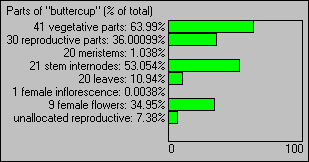Using the Stats panel to evaluate biomass distribution
The Stats panel on the main window (click the Stats tab) shows you how the biomass in the plant is divided up at any time in the plant’s life. You can’t change anything in the Stats panel; it’s just for you to review how your plant is growing.

On each line of the Stats panel is a percentage of the total plant biomass at any time. This shows you how the biomass is distributed. If any type of biomass is not shown, there is no biomass of that type on the plant.
Vegetative/reproductive biomass
The first two lines in the parts panel divide the total plant biomass into two parts: vegetative and reproductive. This breakdown is directly determined by the parameters General parameters: Age at which flowering starts and General parameters: Fraction of total plant biomass at maturity in reproductive structures.
Vegetative parts
Starting at the third line in the Stats panel are listed each type of vegetative part (meristems, internodes, and leaves), with the amount of biomass taken up by all objects of each type. For example, in this buttercup plant, the internodes are taking up much more biomass than the leaves, which means the Optimal plant biomass parameter is higher than it probably should be in the Internodes section and lower than it should be in the Leaves section. In this example the meristems have only a little biomass; this is probably because most of them are inactive (no branching), and one of them has already produced an inflorescence.
Reproductive parts
Under the vegetative parts are listed the reproductive parts (inflorescences, primary and secondary8PBK.ED flowers and flower buds, fallen flowers, unripe fruits, ripe fruits). In this example the inflorescence uses very little biomass, and the flowers use much more. There are no fruits on this plant, as you can see.
Unallocated biomass
Under the reproductive parts are listed two important numbers: the amount of biomass that is in the plant but could not be allocated to any plant parts (vegetative and reproductive handled separately). This means that the daily demands made by plant parts fell short of the actual new biomass that was available. When this happens the extra biomass is placed in this holding area until it is needed. You should try to minimize the amount of biomass shown here. Amounts shown here are usually due to one of two things.
▪ Speed-limit parameters such as Minimum days to grow in several of the parameter sections can make the plant’s S-curve of growth overstep its ability to allocate the new biomass to plant parts. To solve this problem, you can reduce some of these speed-limit parameters and/or increase the lifespan of the plant (General parameters: Age at maturity). For reproductive parts, changing the parameter General parameters: Age at which flowering starts can give the reproductive parts more time to grow.
▪ If the amount of biomass each plant part attempts to accumulate is too low, there will be some biomass left over. This parameter is called Optimal final biomass in the Internodes, Leaves, Flowers, Inflorescences, and Fruit sections. You can figure out what these percentages should be roughly by dividing one hundred percent (the standardized maximum plant biomass or MPB) by the number of internodes, leaves, etc on your plant. You don’t have to figure it out yourself; just change the appropriate parameter. The plant will immediately regrow and you can go back to the Stats panel and see if there is still some unallocated biomass. If you require too much biomass for any type of plant part, though, you might cause the plant to make fewer parts and appear smaller.
Complete list
The complete list of biomass types shown is: all vegetative; all reproductive; meristems; stem internodes; seedling leaves; leaves; primary inflorescences; primary flower buds; primary flowers; secondary8PBK.ED inflorescences; secondary flower buds; secondary flowers; fallen flowers (only shown if flowers have fallen off by the parameter Flowers: Days until drop if fruit not set); unripe fruits; ripe fruits; fallen fruits (should never appear, left over from previous work); unallocated vegetative; unremoved vegetative (should never appear, left over from previous work); unallocated reproductive; and unremoved reproductive (should never appear, left over from previous work).
Created with the Personal Edition of HelpNDoc: Free Kindle producer